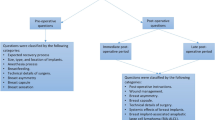Abstract
Introduction and hypothesis
Social media content related to patient experiences and education continues to grow. Information on how obstetric perineal lacerations are represented on social media is limited. Our goal is to characterize available social media content on obstetric perineal lacerations.
Methods
This is an IRB-exempt study using publicly available data on commonly searched topics about perineal lacerations to create a list of queries for Instagram and TikTok. The ten queries and “keyword” searches with the highest number of posts were identified from this list. The 50 most recent posts were reviewed for relevance, quality of content, and authorship. Topic-relevant posts were analyzed.
Results
The search yielded 427 posts on Instagram and 500 on TikTok. Instagram yielded more topic-relevant posts than TikTok (94.1% vs 44.8%). Almost 50% of posts were categorized as educational. Instagram identified more patient experience-related posts (29.6%) whereas TikTok provided more humorous content (26.3%). Patients produced 27.6% of content on Instagram and 43.3% on TikTok. Physical therapists produced 18.9% of posts on Instagram and 21.9% on TikTok. They constituted the largest group of health professionals to post overall. Physician-created educational content accounted for 10.3% of posts on Instagram and 6.0% on TikTok.
Conclusions
Compared with TikTok, Instagram may be a more informative social media platform for educational or patient experience-related content. Given the paucity of physician-created content and given that only half of all posts are educational, providers should encourage social media engagement for community and networking purposes, while encouraging caution with regard to cosmetic products and advertisements.



Similar content being viewed by others
References
Most popular social networks worldwide as of October 2021, ranked by number of active users. Available at: https://www.statista.com/statistics/272014/global-social-networks-ranked-by-number-of-users/. Accessed 29 November 2021.
Minaglia S, Kaneshiro B, Soules K, et al. Assessment of internet-based information regarding pelvic organ prolapse and urinary incontinence. Female Pelvic Med Reconstr Surg. 2012;18(1):50–4. https://doi.org/10.1097/spv.0b013e31823e9fe1.
Qin LA, El-Neemany D, Winkler H, Shalom D. #Urogyn: what’s trending on Instagram? A cross-sectional observational study. Female Pelvic Med Reconstr Surg. 2020;26(5):283–6. https://doi.org/10.1097/spv.0000000000000869.
Alas A, Sajadi KP, Goldman HB, Anger JT. The rapidly increasing usefulness of social media in urogynecology. Female Pelvic Med Reconstr Surg. 2013;19(4):210–3. https://doi.org/10.1097/spv.0b013e3182909872.
Life after 4th degree tears. Raising awareness about 4th degree tears. Available at https://4thdegreetears.wordpress.com/.
Hickman LC, Propst K, Swenson CW, et al. Subspecialty care for peripartum pelvic floor disorders. Am J Obstet Gynecol. 2020;223(5):709–14. https://doi.org/10.1016/j.ajog.2020.08.015.
Geynisman-Tan JM, Taubel D, Asfaw TS. Is something missing from antenatal education? A survey of pregnant women's knowledge of pelvic floor disorders. Female Pelvic Med Reconstr Surg. 2018;24(6):440–3. https://doi.org/10.1097/SPV.0000000000000465.
ACOG Committee Opinion No. 736. Optimizing postpartum care. Obstet Gynecol. 2018;131(5):e140–50. https://doi.org/10.1097/AOG.0000000000002633.
Henderson V, Stumbras K, Caskey R, et al. Understanding factors associated with postpartum visit attendance and contraception choices: listening to low-income postpartum women and health care providers. Matern Child Health J. 2016;20(Suppl 1):132–43. https://doi.org/10.1007/s10995-016-2044-7.
Dunn AB, Paul S, Ware LZ, Corwin EJ. Perineal injury during childbirth increases risk of postpartum depressive symptoms and inflammatory markers. J Midwifery Womens Health. 2015;60(4):428–36. https://doi.org/10.1111/jmwh.12294.
Asif S, Mulic-Lutvica A, Axfors C, et al. Severe obstetric lacerations associated with postpartum depression among women with low resilience—a Swedish birth cohort study. BJOG. 2020;127(11):1382–90. https://doi.org/10.1111/1471-0528.16271.
Peyser A, Goldstein L, Mullin C, Goldman RH. Fertility education: what’s trending on Instagram. Fertil Res Pract. 2021;7(1):3 https://doi.org/10.1186/s40738-021-00095-6.
Sinha R, Shibata R, Patel A, et al. Social media in minimally invasive gynecologic surgery: what is #trending on Instagram? J Minim Invasive Gynecol. 2021;28(10):1730–4. https://doi.org/10.1016/j.jmig.2021.02.011.
Crann SE, Cunningham S, Albert A, et al. Vaginal health and hygiene practices and product use in Canada: a national cross-sectional survey. BMC Womens Health. 2018;18(1):52 https://doi.org/10.1186/s12905-018-0543-y.
Author information
Authors and Affiliations
Contributions
E. Passarelli: data collection, data analysis, manuscript writing; M. Siddique: data collection, data analysis, manuscript writing; L. Fry: project development, manuscript writing; L. Hickman: project development, data analysis, manuscript writing; K. Propst: project development, data analysis, manuscript writing.
Corresponding author
Ethics declarations
Conflicts of interest
None.
Additional information
Publisher’s note
Springer Nature remains neutral with regard to jurisdictional claims in published maps and institutional affiliations.
Rights and permissions
About this article
Cite this article
Passarelli, E., Siddique, M., Fry, L. et al. Perineal lacerations and social media: can patients find reliable information on Instagram and TikTok?. Int Urogynecol J 35, 183–188 (2024). https://doi.org/10.1007/s00192-023-05690-3
Received:
Accepted:
Published:
Issue Date:
DOI: https://doi.org/10.1007/s00192-023-05690-3




